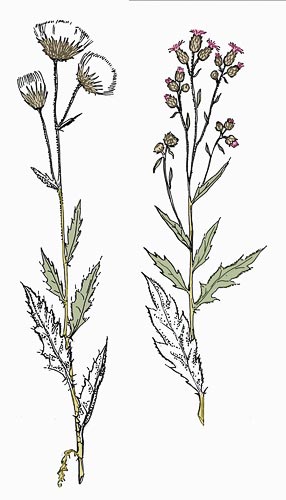Weeds
Cirsium incanum (S.G.Gmel.) Fisch. - White-Felted Thistle.
Systematic position.
Family Asteraceae, genus Cirsium Hill, subgenus Breea (Less.) Tzvel.Synonyms.
Serratula incana S.G.Gmel., Cirsium incanum (S.G.Gmel.) Fisch., Cirsium arvense (L.) Scop. subsp. incanum (S.G.Gmel.) Petrak ex Iljin.Biological group.
Summer-green perennial plant forming offshoots.Morphology and biology.
Root system is well developed. It consists of main stalky root and numerous horizontal lateral rhizomes, which generate new stalks. Stalk is 30-120 cm in height, upright, ramified, striated or costate, wingless or in part winged, cobwebby or white-felt, especially in the upper part. Phyllotaxy alternate. Leaves are 5-10 (max. 15) cm in length and 0.5-3 (max. 6) cm in width, oblong or lanceolate, integral or shallow pinnatilobate, with dense fine marginal thorns. All leaves are white-felt from below, green from above, cobwebby or gray-felt. Middle and upper leaves are sedentary, and lower ones are short-petiolate. Radical leaves die off before blossoming. It is a dioecious plant. Female pistillate flowers are placed in some of calathidia, and male staminate flowers in other ones. Flowers are unisexual owing to insufficient development of either pestles or stamens. Color of flowers is lilac. Limbus of corolla is pentamerous, with lobes being separated from base. Anthers at the basis have apically jagged appendages; staminal filaments are glabrous. Floral calathidia are small (1-2.5 cm in diameter), always upright on cobwebby stalks. One to 4 (less often 20 and more) calathidia are gathered in corymbose-paniculate inflorescence. Receptacle flat with long bracts. Involucre cup-shaped or oblong. Leaflets of involucre pluriserial, imbricate, 1-2 cm in length, slightly cobwebby. External leaflets are ovate, thorn acuminate, internal - lanceolate, narrowed, shortly acuminate. All upper leaflets are cobwebby-ciliate, often violet. Fruit is oblong yellowish or brownish hemicarp with indistinct longitudinal grooves, 3 mm in length, squeezed laterally, glabrous, with long fragile pappus consisting of plumose hairs. Pappus is dirty-white, at flowering being shorter than nimbus, by the end of flowering it extends, being at fruiting almost 3 times longer than nimbus. One plant produces to 4000 seeds. Reproduction by seeds and cloning (by root offsprings). The plant grows from April till October, blossoms from May till July. Seeds ripen in September - October.Distribution.
The general distribution includes Central and Eastern Europe, Central and Southwest Asia. The species is described from Europe (Don River basin). On the territory of the former USSR occurs in the European part (Volga-Don, Dnepr, Moldavian, Black Sea Coast, Trans-Volga and Crimean floristic areas), in the Caucasus, the south of Western Siberia (Upper-Tobolsk, Irtysh, Altai floristic areas), the south of Eastern Siberia (Dauria floristic area), and along river valleys in foothills of Turkmenia.Ecology.
The species prefers damp-meadow type of humidification. It grows on rather rich, neutral and slightly acid soils. It is distributed in broad-leaved forests, steppe, and forest-steppe. In nature the Thistle meets on river banks, meadows, and in steppes, inundated forests. In anthropogenic landscapes it frequently grows in crops, on fallow lands, meadows, pastures, and on garbage places.Economic significance.
Honey plant. It is also a widespread ruderal and segetal plant in the south of steppe. This species replaces Cirsium setosum in crops of the south of the former USSR. It is one of the main weeds of fields and meadows in Crimea, Northern Caucasus, Transcaucasia, Lower Volga basin, and in the Western Kazakhstan. Control measures. It is necessary to destroy regularly rhizomes of the Thistle with the help of appropriate types of soil treatment and herbicides, to escape contamination of sowing material or ground by seeds of the Thistle, to mow off or pull up the weed before fructification. The soil treatment directed to cutting into the finest parts and to digging them deep into ground is the most effective measure against C. incanum. Crop rotation (fallow - winter-crop - row-crop or perennial grasses) may be recommended as the main control measure.Related references.
Cherepanov, S.K. 1995. Vascular plants of Russia and adjacent states (of the former USSR). Saint-Petersburg: Mir i semja-95. 991 pp. (in Russian).Keller, B.A., Lyubimenko, V.N., Maltsev, A.I., Fedchenko, B.A., Shishkin, B.K., Rodzevich, R.Yu. & Kamenskii, K.V., eds. 1934. Weed plants of the USSR. Moscow & Leningrad: AS USSR. V.3. 448 pp. (In Russian)
Maltsev, A.I. 1937. Atlas of the major species of weed plants of the USSR. Moscow & Leningrad: Selkhosgiz. V.1. 168 pp. (in Russian).
Nikitin, V.V. 1983. Weed plants of the USSR flora. Leningrad: Nauka. 454 pp. (in Russian).
Ramenskii, L.G., Tsatsenkin, I.A., Chizhikov, O.N. & Antipin, N.A. 1956. Ecological evaluation of the fodder lands by vegetation cover. Moscow. 472 pp. (in Russian).
Tsvelev, N.N. 2000. Keys to the vascular plants of North-West Russia (Leningrad, Pskov and Novgorod Regions). Saint-Petersburg. 781 pp. (in Russian).


